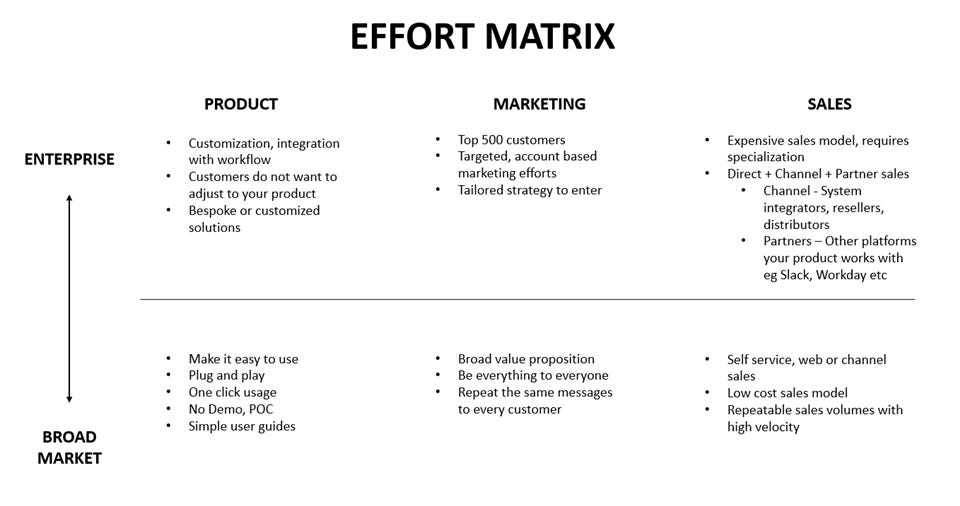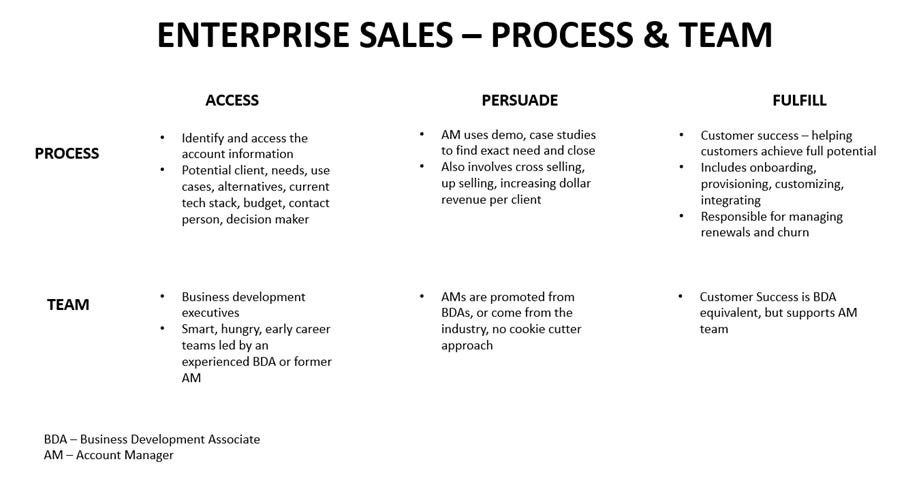#48- A primer on enterprise software sales
An attempt to bring structure and frameworks to enterprise software sales
I have been investing professionally for a little under 3 years now, with the past 18 months as an Associate in early-stage at Malpani Ventures. Our focus is typically towards education, healthcare, diagnostics, enterprise software and the likes.
Over the past few months, engaging with founders in enterprise software, and our portfolio companies like Creditas, Callify, Primaseller etc, I’ve learned more about selling to enterprises than ever before.
In all conversations, I have noticed a few similarities, all of which I want to summarize today. Our CIO is a former consultant, and of late, I’ve found myself borrowing his consulting hat to separate the noise from the signal and think in terms of systems, processes, and frameworks. Today I want to share a few observations and views on structuring sales, looking at sales and marketing functions, setting up teams.
Segmentation
Good sales processes start with a clear segmentation - this is where your company specializes. Most companies start at either the top or the bottom and then migrate to other levels.
For simplicity, we will segment the market into:
Enterprises - The biggest 500 companies in the world or your geography
Mid market - Conglomerates to mid size companies & SMBs
Broad market - Very small companies to Personal use
What can focus look like?
Focus at the top - Only selling to large enterprises
Focus at the bottom - Focusing on broader market, SMBs and personal use software
Focus in a vertical or geography - Selective presence
To summarize
You can choose to focus either top, mid or bottom
OR
in a specialized vertical selling to all of them
OR
in a particular geography focusing on either in the pyramid, or all of them in a vertical
The important message here is to understand what are you selling, and to whom - for this acts as the foundation of your sales and marketing efforts.
Next, we will dive into how segmentation helps the rest of the team think and plan their efforts.
Effort Matrix
For simplicity, we will try to understand the sales effort by dividing the function into three components - Product, Marketing, and Sales. I call it the Effort Matrix.
Inbound vs Outbound
Here, I want to further segregate sales and marketing functions via inbound and outbound efforts
Finally moving to the crux of enterprise sales - the process & team!
Enterprise Sales Process & Team
Most broad market sales are expected to be plug and play versions of software purchases, which means once the customer purchases, enters their credit card details, and clicks a couple of times - the sales process is completed
For the purpose of this illustration we will consider top & mid market enterprise sales
We will split the sales process & team in three broad areas of operation:
Access
Persuade
Fulfill
Accessing the account
Process
This is the process of identifying and accessing the account. Business Development Associates identify leads - they find all available information of a potential client like their needs, use cases, alternatives used, budget, contact person, decision maker etc.
Team
Business Development Associates are usually smart, hungry, fresh out of college graduates usually in their first or second jobs
Persuading the account
Process
Once the leads are identified, they are handed over to the Account Manager or Account Executive to close. AMs use demos, POCs, case studies, and their relationships to understand the exact need, potential use cases, and try to close the sale.
There is no one-size-fits-all approach here. At times, there is customization required before closing, which involves constant communication with the product team. AMs also are handed over cross-selling, up-selling and multi-division acquisition strategies to increase dollar revenue per company.
Team
Account Managers or AMs typically evolve from high performing Business Development Associates. AMs are more experienced than BDAs, and usually have 5+ years of experience under their belt. There is no cookie cutter approach to hiring an AM - they come from different backgrounds and experiences. Usually, AMs move on into leading BDA teams, or into management roles after their tenure
Fulfilling the account
Process
Fulfillment is essentially customer success. This role is measured by how well do you help your customer succeed when they use your product. The role encompasses on-boarding, provisioning, customization and integrations along the way and most importantly taking care of renewal and churn
Team
Typically these roles are equivalent to BDAs, and work closely with the AM function when it comes to support
To summarize
I don’t come from a sales background, hence most of the above is from conversations with founders and understanding the industry. I have also closely looked at a few enterprise software companies in the past - and some key areas where most mistakes happen are:
Lack of focus, not segmenting the market, trying to be everything to everyone
No direction in sales & marketing efforts
Using the wrong marketing techniques for the wrong target customer
If you closely see, most of the errors occur in Segmentation, Effort Matrix and Inbound vs Outbound reach. These are costly errors in a young startup which can be avoided by using simple frameworks.
Enterprise sales is tough! But its not impossible.
Read my other posts on enterprise sales
#8- How to conduct productive user interviews
#51- How to determine the right sales model for your SAAS startup?









Tough, but not impossible. Meaning it is all the more worthwhile to try and keep trying! Thank you for your outsider insight!